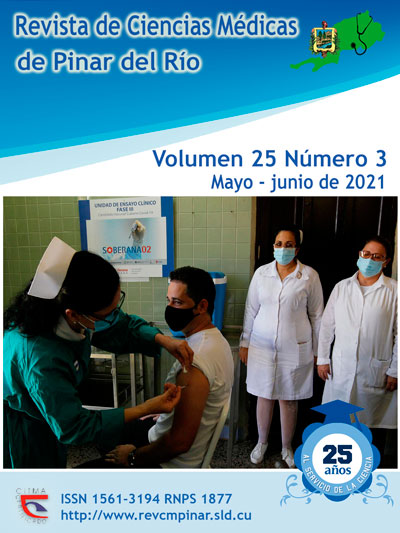Hospital-clinical information system: prototype for volume and dietary indications
Keywords:
MEDICAL RECORDS, TREATMENT, THERAPEUTIC USES, DIET, HOSPITAL INFORMATION SYSTEMS.Abstract
Introduction: a medical indication for patient’s diet is the therapeutic where the food and nutrients are used with curative purposes. The medical indications are daily and manually recorded in the official models on paper format of the clinical histories.
Objective: to develop the architecture of information for the management process of volume and dietary indications in the clinical histories.
Methods: a research-technological development study was conducted using theoretical and empirical methods to study the evolution and development of the treatment plan of hospitalized patients at Leon Cuervo Rubio Clinical-surgical-teaching Hospital from Pinar del Rio province.
Results: the prototype of a computerized system was built for the management of the information records for the medical indications of volume and diet to hospitalized patients. The prototype was created as a whole with the clients, this way satisfying their needs and desires.
Conclusions: the architecture of information for the management of the medical indications concerning volume and diet will allow to the programmers to facilitate the analysis of the desired functionalities for the clients, and implement a computerized application which will replace the register of the medical indications for the volume and diet of the traditional written clinical history, simplifying the working tasks to the healthcare professionals and offering a better care to the patient.
Downloads
References
1.Tomalá Espín JE, Yanza Montalván ÁO. Historia clínica comunitaria informatizada para uso en atención primaria de salud y ambiente (Aps-Apa), aplicada en comunidades del Manglar del Golfo de Guayaquil “Cerrito de los Morreños”. Novus Científica 6.0 [Internet]. 2016 [citado 17/12/2020]; 3(1): [aprox. 24 p.]. Disponible en: http://repositorio.ug.edu.ec/handle/redug/10270
2.Galeano Zaldívar L, Esquenazi Borrego A. El sistema de salud cubano: una mirada a su forma de financiamiento.Econ. y Desarrollo [Internet]. 2019 [citado 17/12/2020];162(2): [aprox. 12 p.]. Disponible en: http://scielo.sld.cu/scielo.php?script=sci_arttext&pid=S0252-85842019000200014&lng=es&tlng=en
3.Albo Castro MM, Coca Bergolla Y. Importancia de la calidad de la distribución GNU/Linux Nova para la informatización del sistema de salud de Cuba. Revista Cubana de Información en Ciencias de la Salud [Internet]. 2020 [citado 18/12/2020]; 31(4): [aprox. 10 p.]. Disponible en: https://brapci.inf.br/index.php/res/v/149788
4.Gutiérrez Vera D, Chávez Meza GA, SantizoPitto NM, García Savon Y, Morasen Robles E, Duany Osoria L. Habilidades informacionales en el uso del Galen Clínicas con enfoque en Sistemas de Información en Salud. Revista Cubana de Tecnología de la Salud [Internet]. 2020 [citado 18/12/2020]; 11(1): [aprox. 7 p.]. Disponible en: https://www.medigraphic.com/pdfs/revcubtecsal/cts-2020/cts201d.pdf
5.Martín Folgueras T, Velasco Gimeno C, Salcedo Crespo S, Segurola Gurrutxaga H, Benítez Brito N, Ballesteros Pomar MD, et al. Proceso de alimentación hospitalaria. Nutr. Hosp. [Internet]. 2019 Jun [citado 18/12/2020]; 36(3): 734-42. Disponible en: http://scielo.isciii.es/scielo.php?script=sci_arttext&pid=S0212-16112019000300034&lng=es
6.Pérez Ayala D, Hernández Castro Y, Álvarez Osorio CA Álvarez Sánchez Y, Rodríguez Fuego MC. Software de gestión para la Historia Clínica de Estomatología General Integral Rev Ciencias Médicas [Internet]. 2016 Dic [citado 18/12/2020]; 20(6): 41-7. Disponible en: https://www.medigraphic.com/pdfs/pinar/rcm-2016/rcm166g.pdf
7.Labrador Falero DM, Rodríguez Fuego MC, Tellería Prieto MC, Mato González A, Oliva Ordaz LA. Diseño del software de gestión “Medical Records Orthodont-Soft”. Revista de Ciencias Médicas de Pinar del Río. [Internet]. 2016 [citado 18/12/2020]; 20(5): 577-83 Disponible en: http://scielo.sld.cu/pdf/rpr/v20n5/rpr07516.pdf
8.Casuriaga A, Giachetto G, Gutiérrez S, Martínez V, García A, Martínez F, et al. Auditorías de historias clínicas: una herramienta de evaluación de la calidad asistencial. Hospìtal Pediátrico- Centro Hospitalario Pereira Rossell. ArchPediatrUrug [Internet]. 2018 [citado 17/12/2020]; 89(4): [aprox. 9 p.]. Disponible en: http://www.scielo.edu.uy/pdf/adp/v89n4/1688-1249-adp-89-04-242.pdf
9.Perea Vásquez LE, Rojas Torres IL. Modelos de gestión en instituciones hospitalarias. Revista Gerencia y Políticas de Salud. [Internet].2019 [citado 17/12/2020]; 18(36): [aprox. 9 p.]. Disponible en: https://revistas.javeriana.edu.co/files-articulos/RGPS/18-36%20%282019-I%29/54559086013/
10.Sistema de gestión hospitalaria. [Internet].2016 [citado 17/12/2020]: [aprox. 15 p.]. Disponible en: https://grupoptm.com/sistema-de-gestion-hospitalaria-his/
11.Sistema de información para clínicas y hospitales HIS. [Internet]. 2016 [citado 17/12/2020] Disponible en: http://www.sisinf.com/es/his-software-para-hospitales.php
12.GNU Health, software libre para el sector sanitario[Internet]. 2016[citado 17/12/2020].Disponible en: https://www.muylinux.com/2016/01/12/gnu-health-software-libre-sector-sanitario/
13. Sistema de Información Hospitalaria SIH Galen Clínica. [Internet]. 2019 [citado 17/12/2020].Disponible en: www.facmed.unam.mx/computo/ssa/HIS/h.pfd
[Internet]. [citado 17 dic 2020] Disponible en: www.facmed.unam.mx/computo/ssa/HIS/h.pfd
Downloads
Published
How to Cite
Issue
Section
License
Authors who have publications with this journal agree to the following terms: Authors will retain their copyrights and grant the journal the right of first publication of their work, which will be publication of their work, which will be simultaneously subject to the Creative Commons Attribution License (CC-BY-NC 4.0) that allows third parties to share the work as long as its author and first publication in this journal are indicated.
Authors may adopt other non-exclusive license agreements for distribution of the published version of the work (e.g.: deposit it in an institutional telematic archive or publish it in a volume). Likewise, and according to the recommendations of the Medical Sciences Editorial (ECIMED), authors must declare in each article their contribution according to the CRediT taxonomy (contributor roles). This taxonomy includes 14 roles, which can be used to represent the tasks typically performed by contributors in scientific academic production. It should be consulted in monograph) whenever initial publication in this journal is indicated. Authors are allowed and encouraged to disseminate their work through the Internet (e.g., in institutional telematic archives or on their web page) before and during the submission process, which may produce interesting exchanges and increase citations of the published work. (See The effect of open access). https://casrai.org/credit/



